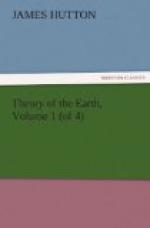But there is a thing in which history and the present state of things do not agree. It is upon the coast of Spain, where Polybius says there was an island in the mouth of the harbour of New Carthage. At present, in place of the island, there is only a rock under the surface of the water. It must be evident, however, that the loss of this small island affords no proper ground of calculation for the measure or rate of wasting which could correspond to the coast in general; as neither the quantity of what is now lost had been measured, nor its quality ascertained.
Let us examine places much more exposed to the fury of the waves and currents than the coast of Carthagena, the narrow fretum, for example, between Italy and Sicily. It does not appear, that this passage is sensibly wider than when the Romans first had known it. The Isthmus of Corinth is also apparently the same at present as it had been two or three thousand years ago. Scilla and Charibdis remain now, as they had been in ancient times, rocks hazardous for coasting vessels which had to pass that strait.
It is not meant by this to say, these rocks have not been wasted by the sea, and worn by the attrition of moving bodies, during that space of time; were this true, and that those rocks, the bulwarks of the land upon those coasts, had not been at all impaired from that period, they might remain for ever, and thus the system of interchanging the place of sea and land upon this globe might be frustrated. It is only meant to affirm, that the quantity which those rocks, or that coast, have diminished from the period of our history, has either been too small a thing for human observation, or, which is more probable, that no accurate measurement of the subject, by which this quantity of decrease might have been ascertained, had been taken and recorded. It must be also evident, that a very small operation of an earthquake would be sufficient to render every means of information, in this manner of mensuration, unsatisfactory or precarious.
Pliny says Italy was distant from Sicily a mile and a half; but we cannot suppose that this measure was taken any otherwise than by computation, and such a measure is but little calculated to afford us the just means of a comparison with the present distance. He also says, indeed, that Sicily had been once joined with Italy. His words are: “Quondam Brutio agro cohaerens, mox interfuso mari avulsa.[18]” But all that we can conclude from this history of Pliny is, that, in all times, to people considering the appearances of those two approached coasts, it had seemed probable, that the sea formed a passage between the two countries which had been once united; in like manner as is still more immediately perceived, in that smaller disjunction which is made between the island of Anglesey and the continent of Wales.
[Note 18: Lib. 3. cap. 8.]




